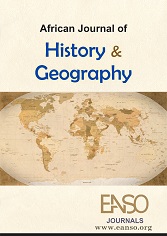A History of the Ndrukpa (Lendu): The Invisible Ethnic Minority Community in Uganda
Abstract
This paper documents the history of the Ndrukpa (Lendu) people; an invisible ethnic minority community in the West Nile region of Uganda. Ndrukpa is an indigenous ethnic community and the first inhabitants of the West Nile and parts of the Acholi subregion. The Ndrukpa – often known as the Lendu - belong to the Sudanic ethnic groups of Uganda and are one of the country's marginalised groups. Ndrukpa population in Uganda is approximately 18,000, and the global population stands at 1,411,000 people, with the majority living in the Democratic Republic of the Congo (DRC). The central thesis of this paper is that contemporary social exclusion of ethnic minority communities such as the Ndrukpa is a historical manipulation and a colonial legacy often tracing their roots to the colonial divide and rule structure. These structures continue to be evoked and used by contemporary ethnic and political stakeholders to their advantage. Social exclusion is often aggravated as in the case of the Ndrukpa people, when their history remains undocumented. Documenting the history of a socially excluded ethnic minority community can be used as a tool and strategy to end social exclusion
Downloads
References
Bah, A. B., & Barasa, M. N. (2023). Indigenous knowledge and the social construction of patriarchy: the case of the Bukusu of Kenya. Critical Sociology, 49(2), 217-232. https://doi.org/10.1177/08969205211063842
Bryman, A. (2012). Social research methods. 4th edition, Oxford University Press UK
Claessen, H. J. (1996). Ideology and the Formation of Early States; Data from Polynesia. Ideology and the formation of early states, 339-358.
Dalfovo, T. A. (2007). Perception of time among the Lugbara. Anthropos, 102(1), 205-213.
Elzain, I. S. (N.D) MEROE, THE CITY STATE, THE KINGDOM, THE EMPIRE WHY MEROE?
Fattovich, R., Manzo, A., & Bard, K. A. (1998). Meroe and Aksum: New elements of comparison. Archéologie du Nil moyen, 8, 43-53.
Hindess, B. (2006). The Althusserian moment and the concept of historical time. Economy and Society, 36(1), 1–18. https://doi.org/10.1080/03085140601089812
Hopkin M (16 February 2005). "Ethiopia is top choice for cradle of Homo sapiens". Nature. doi:10.1038/news050214-10
Johnston, H. H. (1902). The Uganda protectorate; an attempt to give some description of the physical geography, botany, zoology, anthropology, languages and history of the territories under British protection in East Central Africa, between the Congo Free State and the Rift Valley and between the first degree of south latitude and the fifth degree of north latitude. Dalcassian Publishing Company
Miller, C. (2018). Language and ethnic statistics in twentieth-century Sudanese censuses and surveys. International Journal of the Sociology of Language, 2018(252), 125–152. doi:10.1515/ijsl-2018-0017
Ndrukpa Kingdom (2019). The Oral History, Customs and Traditions of the Ndrukpa.
Ortner, S. B. (2022). Patriarchy. Feminist Anthropology, 3(2), 307-314. doi:10.1002/fea2.12081
Uganda Bureau of Statistics 2016, The National Population and Housing Census 2014 – Main Report, Kampala, Uganda
Copyright (c) 2024 Agatha Alidri, Charlotte Karungi Mafumbo, Peter John Opio

This work is licensed under a Creative Commons Attribution 4.0 International License.




























